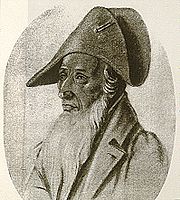
Nethaneel Weil
Encyclopedia


Rabbi
In Judaism, a rabbi is a teacher of Torah. This title derives from the Hebrew word רבי , meaning "My Master" , which is the way a student would address a master of Torah...
and talmudist born at Stühlingen
Stühlingen
Stühlingen is a town in the Waldshut district in Baden-Württemberg, Germany. It is situated on the border with Switzerland, with a border crossing to the village of Oberwiesen in Schleitheim municipality, 15 km northwest of Schaffhausen town....
, son of Naphtali Zvi Hirsch Weil.
Biography
His mother took him to FürthFürth
The city of Fürth is located in northern Bavaria, Germany in the administrative region of Middle Franconia. It is now contiguous with the larger city of Nuremberg, the centres of the two cities being only 7 km apart....
when he was ten years old, and soon afterward to Prague
Prague
Prague is the capital and largest city of the Czech Republic. Situated in the north-west of the country on the Vltava river, the city is home to about 1.3 million people, while its metropolitan area is estimated to have a population of over 2.3 million...
, where his father's brother, Lippman Weil, adopted him. Although so young, he was granted permission to attend the lectures of R. Abraham Brod, head of the Prague yeshiva
Yeshiva
Yeshiva is a Jewish educational institution that focuses on the study of traditional religious texts, primarily the Talmud and Torah study. Study is usually done through daily shiurim and in study pairs called chavrutas...
; R. Abraham was so impressed with him that he arranged a match between him and R. Abraham's niece, Vögele. The wedding was celebrated in 1708, and when R. Abraham was called to the rabbinate of Mainz
Mainz
Mainz under the Holy Roman Empire, and previously was a Roman fort city which commanded the west bank of the Rhine and formed part of the northernmost frontier of the Roman Empire...
, Nethanel came with him. In 1713 he returned to Prague, where he occupied himself with Talmudic studies and with teaching thousands of students, while drawing a scanty salary as assistant rabbi of Prague.
Weil remained in Prague until the issue of the edict of Maria Theresa of Austria
Maria Theresa of Austria
Maria Theresa Walburga Amalia Christina was the only female ruler of the Habsburg dominions and the last of the House of Habsburg. She was the sovereign of Austria, Hungary, Croatia, Bohemia, Mantua, Milan, Lodomeria and Galicia, the Austrian Netherlands and Parma...
of Dec. 18, 1744, ordering the expulsion of all Jews from Bohemia
Bohemia
Bohemia is a historical region in central Europe, occupying the western two-thirds of the traditional Czech Lands. It is located in the contemporary Czech Republic with its capital in Prague...
. This proved to be the means of releasing him from a burdensome existence, for he was then offered the rabbinate of the Black Forest
Black Forest
The Black Forest is a wooded mountain range in Baden-Württemberg, southwestern Germany. It is bordered by the Rhine valley to the west and south. The highest peak is the Feldberg with an elevation of 1,493 metres ....
, with headquarters in Mühringen (near Horb am Neckar
Horb am Neckar
Horb am Neckar is a town in the southwest of the German state of Baden-Württemberg. It is located on the Neckar river, between Offenburg to the west and Tübingen to the east . It has around 25,000 inhabitants, of whom about 6,000 live in the main town of Horb, and the remainder in 18 associated...
). He assumed office in 1745, and held it for five years, writing the greater part of his commentary on Asher ben Jehiel
Asher ben Jehiel
Asher ben Jehiel- Ashkenazi was an eminent rabbi and Talmudist best known for his abstract of Talmudic law. He is often referred to as Rabbenu Asher, “our Rabbi Asher” or by the Hebrew acronym for this title, the ROSH...
during that time. In 1750 he was called as rabbi to Karlsruhe
Karlsruhe
The City of Karlsruhe is a city in the southwest of Germany, in the state of Baden-Württemberg, located near the French-German border.Karlsruhe was founded in 1715 as Karlsruhe Palace, when Germany was a series of principalities and city states...
, and there he completed the commentary in the spring of 1754. It was published at Karlsruhe in 1755 under the title Korban Nethan'el, and was later printed together with Asheri in editions of the Talmud, although it embraces only the orders Moed
Moed
Moed is the second Order of the Mishnah, the first written recording of the Oral Torah of the Jewish people . Of the six orders of the Mishna, Moed is the third shortest. The order of Moed consists of 12 tractates:# Shabbat: or Shabbath deals with the 39 prohibitions of "work" on the Shabbat...
and Nashim
Nashim
Nashim is the third order of the Mishnah , containing the laws related to women and family life...
.
Nethaneel officiated in Karlsruhe for about twenty years, and died at Rastatt
Rastatt
Rastatt is a city and baroque residence in the District of Rastatt, Baden-Württemberg, Germany. It is located on the Murg river, above its junction with the Rhine and has a population of around 50'000...
on May 7, 1769. In addition to the Ḳorban Netan'el, which was published by himself, he was the author of two works published posthumously by his son Simeon Hirsch:
- Netib Ḥayyim (Fürth, 1779), containing critical notes on the Shulhan Aruk, Oraḥ Ḥayyim, and its commentaries, the Ṭure Zahab and Magen Abraham
- Torat Netan'el (ib. 1795), in two parts, the first consisting of a collection of his responsa, and the second consisting of halakic derashot on the Pentateuch
Jewish Encyclopedia bibliography
- L. Löwenstein, Beiträge zur Gesch. der Juden in Deutschland, ii, Frankfort-on-the-Main, 1898;
- Steinschneider, Cat. Bodl. col. 2053;
- Fürst, Bibl. Jud. iii.501.

